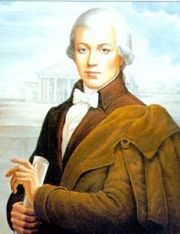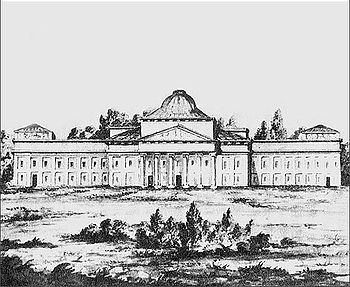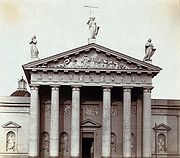
Laurynas Gucevicius
Encyclopedia

Polish-Lithuanian Commonwealth
The Polish–Lithuanian Commonwealth was a dualistic state of Poland and Lithuania ruled by a common monarch. It was the largest and one of the most populous countries of 16th- and 17th‑century Europe with some and a multi-ethnic population of 11 million at its peak in the early 17th century...
, the Grand Duchy of Lithuania
Grand Duchy of Lithuania
The Grand Duchy of Lithuania was a European state from the 12th /13th century until 1569 and then as a constituent part of Polish-Lithuanian Commonwealth until 1791 when Constitution of May 3, 1791 abolished it in favor of unitary state. It was founded by the Lithuanians, one of the polytheistic...
, and most of his designs were built there.
In his youth he travelled to Italy
Italy
Italy , officially the Italian Republic languages]] under the European Charter for Regional or Minority Languages. In each of these, Italy's official name is as follows:;;;;;;;;), is a unitary parliamentary republic in South-Central Europe. To the north it borders France, Switzerland, Austria and...
and Paris
Paris
Paris is the capital and largest city in France, situated on the river Seine, in northern France, at the heart of the Île-de-France region...
and other countries in Western Europe
Western Europe
Western Europe is a loose term for the collection of countries in the western most region of the European continents, though this definition is context-dependent and carries cultural and political connotations. One definition describes Western Europe as a geographic entity—the region lying in the...
, where he studied architecture under the notable contemporary neo-classical French
France
The French Republic , The French Republic , The French Republic , (commonly known as France , is a unitary semi-presidential republic in Western Europe with several overseas territories and islands located on other continents and in the Indian, Pacific, and Atlantic oceans. Metropolitan France...
architects, Jacques-Germain Soufflot
Jacques-Germain Soufflot
Jacques Germain Soufflot was a French architect in the international circle that introduced Neoclassicism. His most famous work is the Panthéon, Paris, built from 1755 onwards, originally as a church dedicated to Sainte Genevieve.- Biography :Soufflot was born in Irancy, near Auxerre.In the 1730s...
and Claude Nicolas Ledoux
Claude Nicolas Ledoux
Claude-Nicolas Ledoux was one of the earliest exponents of French Neoclassical architecture. He used his knowledge of architectural theory to design not only in domestic architecture but town planning; as a consequence of his visionary plan for the Ideal City of Chaux, he became known as a utopian...
. Later he was appointed professor at the Jesuit Academy of Vilnius, the predecessor of the University of Vilnius. Among the best known of his works are the Vilnius Cathedral
Vilnius Cathedral
The Cathedral of Vilnius is the main Roman Catholic Cathedral of Lithuania.It is situated in Vilnius Old Town, just off of Cathedral Square. It is the heart of Lithuania's Catholic spiritual life....
, the town hall and the summer palace of bishops
Verkiai Palace
Verkiai Palace is an 18th century neoclassical mansion in Verkiai, Vilnius, Lithuania.- History :Until the end of 14th century this place was a property of the Grand Dukes of Lithuania. There was a wooden manor even in 13th century. In 1387 Lithuanian Grand Duke Jogaila, on occasion of accepting...
in Verkiai
Verkiai
Verkiai is a northernmost eldership in Vilnius, Lithuania. Historically it was a separate settlement situated north of Vilnius but today it is a part of Vilnius city municipality. It occupies 5,565 ha and has 30,000 inhabitants...
. The monumentality of forms and volume, the harmony with surroundings and a special treatment of antique architectural forms are the characteristics of his style.
Biography
Born in the village of MigonysMigonys
Migonys is a village in the Kupiškis district municipality, Lithuania. According to the 2001 census, it had 132 inhabitants. The village celebrated its 400th anniversary in 1924. There is a hill-fort and 36 tumuli in the vicinity of the village....
near Kupiškis
Kupiškis
Kupiškis is a city in north-eastern Lithuania. It is the capital of the Kupiškis district municipality. Kupiškis is situated on the Lėvuo and Kupa rivers. The name of the city originates from Kupa River. Gediminas bridge crosses river Kupa.-History:...
, in the Grand Duchy of Lithuania
Grand Duchy of Lithuania
The Grand Duchy of Lithuania was a European state from the 12th /13th century until 1569 and then as a constituent part of Polish-Lithuanian Commonwealth until 1791 when Constitution of May 3, 1791 abolished it in favor of unitary state. It was founded by the Lithuanians, one of the polytheistic...
. His father was a peasant Simonas Masiulis , sometimes also called by the name of Stuoka after his stepfather. He was baptized as Laurynas Masiulis. His mother, Kotryna Žekonytė Masiulienė , died early in his youth, and her relative and his godmother Ona Baltušytė Gucevičienė , supported him and financed his studies. After her he changed his surname to Gucewicz/Gucevičius. He attended local schools at Kupiškis and Palėvenė and then the gymnasium (high school) at Panevėžys
Panevežys
Panevėžys see also other names, is the fifth largest city in Lithuania. As of 2008, it occupied 50 square kilometers with 113,653 inhabitants. The largest multifunctional arena in Panevėžys is the Cido Arena...
. In 1773 he joined the Academy of Vilnius. He studied engineering, attended the lectures on architecture held by Marcin Knackfus
Marcin Knackfus
Marcin Knackfus was a Polish–Lithuanian Neoclassical architect of German descent. Born near Warsaw, he worked in the Grand Duchy of Lithuania and particularly in its capital Vilnius...
. Around that time, he also became a missionary monk
Missionary order
A missionary order is a religious order of the Roman Catholic church devoted to active missionary work....
.
He graduated in 1775 and in the following year received a royal scholarship from King Stanisław August Poniatowski. Along with a large number of other young Polish artists and architects of the time (among them Chrystian Piotr Aigner
Chrystian Piotr Aigner
Chrystian Piotr Aigner was a Polish architect and theoretician of architecture.-Life:...
, Szymon Bogumił Zug, Stanisław Zawadzki, Efraim Szreger and Jakub Kubicki
Jakub Kubicki
Jakub Kubicki was a renowned Polish classicist architect and designer. One of the most renowned architects of his epoch, since 1781 he was the personal architect of king Stanisław August Poniatowski. Among the most notable of his works are a number of palaces and summer residences in Poland,...
), he went to Rome
Rome
Rome is the capital of Italy and the country's largest and most populated city and comune, with over 2.7 million residents in . The city is located in the central-western portion of the Italian Peninsula, on the Tiber River within the Lazio region of Italy.Rome's history spans two and a half...
, where he spent a year studying the classical architecture.

Western Europe
Western Europe is a loose term for the collection of countries in the western most region of the European continents, though this definition is context-dependent and carries cultural and political connotations. One definition describes Western Europe as a geographic entity—the region lying in the...
, where he attended lectures on architecture and learned from the works of the most renowned architects of the time. He visited France
France
The French Republic , The French Republic , The French Republic , (commonly known as France , is a unitary semi-presidential republic in Western Europe with several overseas territories and islands located on other continents and in the Indian, Pacific, and Atlantic oceans. Metropolitan France...
, Denmark
Denmark
Denmark is a Scandinavian country in Northern Europe. The countries of Denmark and Greenland, as well as the Faroe Islands, constitute the Kingdom of Denmark . It is the southernmost of the Nordic countries, southwest of Sweden and south of Norway, and bordered to the south by Germany. Denmark...
, Sweden
Sweden
Sweden , officially the Kingdom of Sweden , is a Nordic country on the Scandinavian Peninsula in Northern Europe. Sweden borders with Norway and Finland and is connected to Denmark by a bridge-tunnel across the Öresund....
and various German states. He spent a year and a half studying in Paris
Paris
Paris is the capital and largest city in France, situated on the river Seine, in northern France, at the heart of the Île-de-France region...
under the guidance of Jacques-Germain Soufflot
Jacques-Germain Soufflot
Jacques Germain Soufflot was a French architect in the international circle that introduced Neoclassicism. His most famous work is the Panthéon, Paris, built from 1755 onwards, originally as a church dedicated to Sainte Genevieve.- Biography :Soufflot was born in Irancy, near Auxerre.In the 1730s...
and Claude Nicolas Ledoux
Claude Nicolas Ledoux
Claude-Nicolas Ledoux was one of the earliest exponents of French Neoclassical architecture. He used his knowledge of architectural theory to design not only in domestic architecture but town planning; as a consequence of his visionary plan for the Ideal City of Chaux, he became known as a utopian...
. On his return, he was hired by Bishop Ignacy Jakub Massalski
Ignacy Jakub Massalski
Prince Ignacy Massalski was a Polish-Lithuanian nobleman.Ignacy was Bishop of Vilnius and one of the initiators of the Commission for National Education. After few years he was removed from the Commission for embezzlement of public funds...
, for whom he designed and built the episcopal palace in Verkiai
Verkiai Palace
Verkiai Palace is an 18th century neoclassical mansion in Verkiai, Vilnius, Lithuania.- History :Until the end of 14th century this place was a property of the Grand Dukes of Lithuania. There was a wooden manor even in 13th century. In 1387 Lithuanian Grand Duke Jogaila, on occasion of accepting...
, later known after its later owners, the Wittgenstein
Ludwig zu Sayn-Wittgenstein-Berleburg
Prince Ludwig Adolf Friedrich of Sayn-Wittgenstein was a Russian aristocrat of German descent...
family. The palace and the surrounding architectural complex, the work on which was commenced by Gucewicz's tutor Knackfus, is currently considered one of the most valuable classicist complexes in Lithuania.
In 1789 Gucewicz became a professor of architecture and topography
Topography
Topography is the study of Earth's surface shape and features or those ofplanets, moons, and asteroids...
at the Artillery and Engineering Corps' School of Wilno. In 1794 he also returned to his Alma Mater
Alma mater
Alma mater , pronounced ), was used in ancient Rome as a title for various mother goddesses, especially Ceres or Cybele, and in Christianity for the Virgin Mary.-General term:...
, where he became a professor of civilian architecture and held the chair in engineering. In 1794, at the outbreak of Kościuszko's Uprising, Gucewicz joined the ranks of the local civil guard and took part in the Wilno Uprising
Wilno Uprising (1794)
The Wilno Uprising of 1794 began on April 22, 1794, during which Polish-Lithuanian forces led by Jakub Jasiński fought with Russian forces occupying the city during the Kościuszko Uprising. The Russians were expelled from Wilno , and thanks to Jasiński's skill, no casualties were sustained during...
against the Russian garrison. He became one of the leaders of the local militia formed out of volunteers. Wounded in a skirmish near Ashmiany (modern Belarus), he was demobilised. Following the Partitions of Poland
Partitions of Poland
The Partitions of Poland or Partitions of the Polish–Lithuanian Commonwealth took place in the second half of the 18th century and ended the existence of the Polish–Lithuanian Commonwealth, resulting in the elimination of sovereign Poland for 123 years...
, when Vilnius was annexed by Imperial Russia, the new authorities expelled Gucewicz from the academy for his part in the uprising. However, in 1797 he returned there, this time as a head of the newly-founded separate chair of architecture.

Bratslav
Bratslav |Breslov]] as the name of a Hasidic group, which originated from this town) is a townlet in Ukraine, located in the Nemyriv Raion of Vinnytsia Oblast, by the Southern Bug river. It is a medieval European city having dramatically lost its importance during 19th-20th centuries...
(modern Vidzy, Belarus). Between 1777 and in 1801 he worked to rebuild the Vilnius Cathedral
Vilnius Cathedral
The Cathedral of Vilnius is the main Roman Catholic Cathedral of Lithuania.It is situated in Vilnius Old Town, just off of Cathedral Square. It is the heart of Lithuania's Catholic spiritual life....
(which had undergone many reconstructions, and had been partially Baroque
Baroque
The Baroque is a period and the style that used exaggerated motion and clear, easily interpreted detail to produce drama, tension, exuberance, and grandeur in sculpture, painting, literature, dance, and music...
) in the neoclassical style. It is sometimes said that his reconstruction of the cathedral, modelled after a Roman temple, pre-dated the work of Thomas Hamilton
Thomas Hamilton (architect)
Thomas Hamilton was a Scottish architect, based in Edinburgh. Born in Glasgow, his works include: the Dean Orphan Hospital, now the Dean Gallery; the Royal High School on the Calton Hill, long considered as home for the Scottish Parliament; Bedlam Theatre; the George IV Bridge, which spans the...
and James Playfair
James Playfair
James Playfair was a Scottish architect who worked largely in the Neoclassical tradition. He was born in Benvie near Dundee, where his father was the parish minister. He was the brother of William Playfair the engineer, and the mathematician John Playfair...
, two notable Scottish architects to introduce classicism in the United Kingdom
United Kingdom
The United Kingdom of Great Britain and Northern IrelandIn the United Kingdom and Dependencies, other languages have been officially recognised as legitimate autochthonous languages under the European Charter for Regional or Minority Languages...
.
He is credited with a number of other projects, although their actual authorship is not documented. Among them is the palace of the Tyzenhaus
Tyzenhaus
Tyzenhaus was a noble family of the Polish–Lithuanian Commonwealth of German extraction. It was active in the Duchy of Livonia, Duchy of Courland and the northern Grand Duchy of Lithuania...
family in Rokiškis
Rokiškis
Rokiškis is a city in northeastern Lithuania with population of about 16,000.-History:The legend of the founding of Rokiškis tells about a hunter called Rokas who had been hunting for hares . However, cities ending in "-kiškis" are quite popular in the region. The city was first mentioned in 1499...
(completed in 1801), the reconstruction of the castle in Raudonė
Raudone
Raudonė is a town on the Neman River in Tauragė County, Lithuania. The town is primarily known for its castle and a large park complex.- History :...
for its contemporary owners, the Olędzki (Olendzki) h. Rawicz family and the manor house in Čiobiškis. He is also thought to have prepared designs of palaces for other notable magnate families of the time, including Radziwiłł, Sapieha
Sapieha
The Sapieha is a Polish-Lithuanian princely family descending from the medieval boyars of Smolensk. The family acquired great influence in the sixteenth century.-History:...
, Pac, Chomiński and Scypion, though the World War II
World War II
World War II, or the Second World War , was a global conflict lasting from 1939 to 1945, involving most of the world's nations—including all of the great powers—eventually forming two opposing military alliances: the Allies and the Axis...
losses in the preserved archives make the matter difficult to settle definitively. Additionally, he designed several merchant houses in Kretinga
Kretinga
Kretinga is a city in the Klaipėda County, Lithuania. It is the capital of the Kretinga district municipality. It is located east of the popular Baltic Sea resort town of Palanga, and about north of Lithuania's 3rd largest city and principal seaport, Klaipėda.The population was listed as 21,423...
and was the author of a topographic
Topography
Topography is the study of Earth's surface shape and features or those ofplanets, moons, and asteroids...
map of the western part of the city of Vilnius
Vilnius
Vilnius is the capital of Lithuania, and its largest city, with a population of 560,190 as of 2010. It is the seat of the Vilnius city municipality and of the Vilnius district municipality. It is also the capital of Vilnius County...
.
He died December 10, 1798, and was buried in the Rasos Cemetery
Rasos Cemetery
Rasos Cemetery is the oldest and most famous cemetery in the city of Vilnius, Lithuania. It is named after the Rasos district where it is located. It is separated into two parts, the old and the new cemeteries, by a narrow Sukilėliai Street. The total area is 10.8 ha...
, Vilnius, though knowledge of the exact burial location has been lost. In his last will he dedicated all of his projects to the Polish-Lithuanian Commonwealth
Polish-Lithuanian Commonwealth
The Polish–Lithuanian Commonwealth was a dualistic state of Poland and Lithuania ruled by a common monarch. It was the largest and one of the most populous countries of 16th- and 17th‑century Europe with some and a multi-ethnic population of 11 million at its peak in the early 17th century...
, and some of the surviving sketches and designs are currently held in the library of Warsaw University.
Legacy
The architect's life and creations inspired Lithuanian poet Justinas MarcinkevičiusJustinas Marcinkevicius
Justinas Marcinkevičius was a prominent Lithuanian poet and playwright.-Life and career:Marcinkevičius was born in 1930 in Važatkiemis, Prienai district. In 1954 he graduated from Vilnius University History and Philology faculty with a degree in Lithuanian language and Literature. He joined the...
to write the play The Cathedral.

